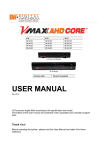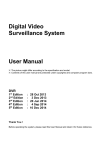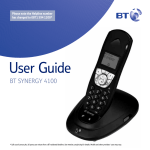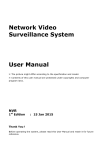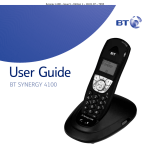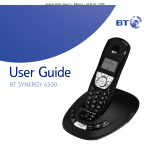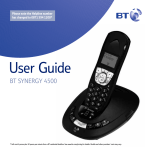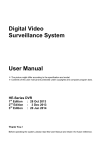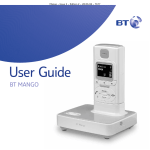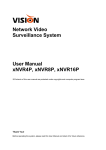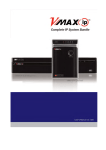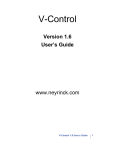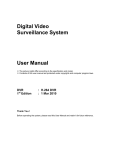Download User Manual - Volutone.com
Transcript
Rev.10/15 WARNING TO REDUCE FIRE OR SHOCK HAZARD, DO NOT EXPOSE THE UNIT TO RAIN OR MOISTURE. The installation should be made by a qualified service person and conformed to all local codes. Cautions Read Before System Operation Follow these details to prevent material damage or personal injury. Signs of Caution and Warning Warning: This sign indicates that the user could die or be seriously wounded if not used or installed properly. Caution: This sign indicates that the user could be wounded or could expect property damage if not used or installed properly. Warning: Do not expose the product to fog, rain or too much humid to decrease danger from electric shock or fire. General Warning Warning 1. Use the power cord, which is supplied or recommended by the supplier, or it may cause fire. 2. Do not disassemble or reassemble the product. It may cause malfunction or fire. 3. Enquire to your vendor for repair. It may cause electric shock or fire if the repair is not done properly. 4. Do not touch the product with wet hands. It may cause malfunction or electric shock. 5. Product installation must be ensured to a professional for product installation, or it may cause malfunction, electric shock or fire. 6. Ground applies to video products equipped with a 3-wire grounding type plug having a third (grounding) pin. This plug only fits into a grounding-type power outlet. If grounding is not done, it may cause malfunction or electric shock. 7. Ground connection must not touch gas pipe, water pipe or telephone line. If grounding is not done properly, it may cause electric shock. 8. Prevent metallic foreign substance from going inside the product. It may cause malfunction or electric shock. 9. Do not spray insecticide or flammable spray while driving. It may cause fire. 10. Place the system in a open place where air ventilation is guaranteed, or it may cause over-heating and seriously damage the system to be fired. 11. Prevent water from instilling inside electrical parts. Clean with a dry towel or malfunction or electric shock could result. Caution 1. Use the power cord, which is supplied or recommended by the supplier. The internal fan rotates at high speed and may cause an accident. 2. Do not drop, give strong vibration, or shock to the product. It may cause malfunction. 3. The air inhaler of the front panel and air outlet of the back panel must not be blocked during installation. The internal temperature of the product would be greater than allowable and could cause malfunction or fire. 4. Do not touch the product or the power cord when there is thunder. It may cause electric shock. 5. Do not install the product near or on top of heating source. The internal temperature of the product would be greater than allowable and could cause malfunction or fire. 6. Do not install the product on inclined or unstable location or where vibration could be committed. It may cause malfunction. Cautions about the Power Warning 1. Must use the outlet of the grounding to connect the power cord, or it may cause fire. 2. Do not connect on the middle of power cord or use extension cord. It may generate heat or cause fire. 3. Do not touch the power cord with wet hands. It may cause electric shock. 4. Keep power cord dry and protect from humidity. It may generate heat or cause fire. The power cord is not waterproof. 5. Hold the body of the plug while removing the power plug. Do not pull the power cord. Damage to the power cord may generate heat or cause fire. 6. Check the power plug regularly. Humidity and moderation in smoking may cause fire. 7. Remove power cord from outlet when product is not used for a long time. It may cause short-circuit or electric shock. Caution 1. Do not turn off the power by removal of the power plug. To turn off the power, click the power button from the front panel. When the system stops abnormally, the power button might not work. Click power button for 5 full seconds to turn power off. 2. Do not cut off the power artificially, or give shock or vibration to unit while the hard disk is activating. It may cause hard disk failure or loss of data. Remarks ※ Pictures and buttons are subject to be changed or modified up to different models. ※ Function or configuration is subject to be changed or modified without prior notice for improvement of the product. 1 | VMAXAHD CORE™ User Manual Contents 1. GETTING STARTED ............................................................................................................................................................... 2 1.1 1.2 1.3 1.4 2. STARTUP WIZARD ................................................................................................................................................................. 7 2.1 2.2 2.3 2.4 2.5 2.6 3. LANGUAGE .............................................................................................................................................................................. 8 DATE/TIME .............................................................................................................................................................................. 8 HDD FORMAT ....................................................................................................................................................................... 9 RECORD................................................................................................................................................................................. 10 NETWORK ..............................................................................................................................................................................11 FINISH ................................................................................................................................................................................... 12 OPERATION ........................................................................................................................................................................... 14 3.1 3.2 3.3 3.4 3.5 3.6 3.7 4. USER LOG-IN ......................................................................................................................................................................... 14 LIVE DISPLAY MODE ............................................................................................................................................................. 14 PTZ OPERATION .................................................................................................................................................................... 17 PLAYBACK RECORDED IMAGES ............................................................................................................................................. 18 QUICK BACKUP DURING PLAYBACK ...................................................................................................................................... 19 SEARCH RECORDED IMAGE ................................................................................................................................................... 19 DST SETTING AND IMAGE PLAYBACK ................................................................................................................................... 23 SETTING ................................................................................................................................................................................. 24 4.1 4.2 4.3 4.4 4.5 4.6 5. SYSTEM ................................................................................................................................................................................. 25 DEVICE................................................................................................................................................................................ 33 EVENT ................................................................................................................................................................................... 37 RECORD .............................................................................................................................................................................. 41 NETWORK .......................................................................................................................................................................... 46 BACKUP .............................................................................................................................................................................. 51 WEB SURVEILLANCE THROUGH M/S IE ....................................................................................................................... 54 5.1 5.2 5.3 5.4 6. CHECKING SUPPLIED ITEMS .................................................................................................................................................... 2 SYSTEM STARTUP .................................................................................................................................................................... 3 BUTTON EXPLANATION ........................................................................................................................................................... 3 SYSTEM SHUTDOWN................................................................................................................................................................ 7 WEB LOGIN ........................................................................................................................................................................... 54 WEB MONITORING ................................................................................................................................................................ 55 WEB PLAYBACK .................................................................................................................................................................... 56 SETUP .................................................................................................................................................................................... 57 Q & A ......................................................................................................................... ERROR! BOOKMARK NOT DEFINED. VMAXAHD CORE™ User Manual | 2 1. Getting Started 1.1 Checking Supplied Items Make sure that you have following items supplied with your DVR. If any of these items are missing or damaged, notify your vendor immediately. Keep the packing utilities for moving or storage purposes afterwards. Items Photo User Manual and Remote Software Quantity 1 Set (*) Quick Manual and CD 12V D/C Adaptor & Power Cable 1 Set or IR Remote Controller 1 Set (*) Type of controller may differ depending on the DVR model and can be replaced by USB Mouse. Terminal Block and Rubber Mount 1 Pair (2 Pieces) 1 Set (*) Packed goods may differ depending on the DVR model *The picture might differ according to the specification and model 3 | VMAXAHD CORE™ User Manual 1.2 System Startup After connecting peripheral devices such as cameras, monitors and a mouse to the DVR, power the DVR by connecting the 12V adaptor to the device. The login window will appear as shown below. To login, enter the username and password in the popup screen. There is only one Administrator Account configurablein the DVR. It is assigned with an unchangeable User ID marked as “ADMIN”. The factory default password is “1234”. The Administrator account has full access to the DVR and its configurable parameters such as creating new users and assigning rights to users. If DVR is set as AUTO LOGIN, login process is not necessary. Caution It may take a few minutes to startup the system after turning on the power. If the network is not connected or the user sets the network configuration as DHCP when no DHCP server is in the network. Note 1) Do not forget the administrator’s password that was set for the first time. In case the password is forgotten, please contact your local dealer for help. 2) Refer to the “Section 4.1.2 User” for AUTO LOGIN and AUTO LOGOFF. 1.3 Button Explanation 1.3.1. Front Panel *The picture might differ according to the specification and model ① ② ③ ④ ⑤ Power LED Indicator Function Button Direction Button Enter Button : System ON/OFF : Indicates system status.(Power, Record and Network status) : E-Backup, Search, Screen display mode, Menu, Return : Move to the desired menu position : Select value or setting VMAXAHD CORE™ User Manual | 4 ⑥ USB Port : For backup, upgrade and so on. 1.3.2. IR Remote Controller 11 ○ 12 ○ 13 ○ 14 ○ 15 ○ 16 ○ 17 ○ ① Power : System ON/OFF ② DVR ID Selection ③ Numeric Button : Channel selection or Password input ④ PTZ Button ⑤ Preset Button : Select Preset on PTZ mode ⑥ Focus Button : Focus IN/OUT on PTZ mode ⑦ ZOOM Button : Zoom IN/OUT on PTZ mode ⑧ Preset Tour : Tour ON/OFF on PTZ mode ⑨ Direction Button ⑩ Enter Button ⑪ Menu Button ⑫ Return Button ⑬ Playback Button on Search mode ⑭ Search Button ⑮ Emergency Recording Button 16 Auto-Sequence Button on Live mode ○ E 18 ○ A 17 Screen Mode Button ○ E A A 18 Backup Button ○ A E A The picture might differ according to the specification and model Note User can control multiple DVRs with one IR Remote Controller. In order to control multiple DVRs, each DVR has different Remote ID. (The initial ID is set as “0”.) Note How to setup the ID # in IR Remote Controller 1) Keep pressing ID selection button for about 5 seconds. 2) Set the ID number by pressing numeric button on IR Remote Controller. ID number is available from 000 up to 255. 3) You have to press numeric button as three-digit number format. For example, press “000” for 0, “023” for 23, “234” for 234. User must set REMOTE ID to match with the ID of the IR remote controller, if the user wants to use it to control the DVR. 1.3.3. Tool Bar on Live Mode In live view, move the mouse cursor to the bottom of the screen to show the menu bar as it appears below. 5 | VMAXAHD CORE™ User Manual Menu Button Click on the menu button to access the DVR’s main menu screen. (Please refer to “4. Setting” for details.) Startup Wizard Button Click on the Startup menu button to access the Startup Wizard. (Please refer to “2. Startup Wizard” for details.) Screen Display Mode Button Click on screen display mode button to switch screen display mode. Select 1ch, 4ch, 9ch, or 16ch mode. PTZ Button Select the PTZ button to control any channel using a PTZ camera. In PTZ mode, you can move pan/tilt and zoom-in/out by moving the mouse pointer, called virtual joystick. Click this button after selecting full screen mode for the channel. (Please refer to the “Section 3.3 PTZ Operation” for details.) Recording Button Select the recording button to urgently start recording. In emergency recording, the system records all channels with full frame rate at the maximum resolution regardless of recording mode setting. To stop emergency recording, click the same icon again. Backup Button Click the backup button to archive video clips taken during a specific time frame. The video content will be stored onto an external device. (Please refer to the “4.6 Backup” for details.) Playback Button Select the playback button to watch recent video clips automatically. (Please refer to the “3.4 Playback Recorded Image” for details.) Search Button Use this button to search recorded videos with various search modes. (Please refer to the “3.6 Search Recorded Image” for details.) Exit Button User can exit with three different options: Log Off, Reboot and Shutdown. Pin Button When selected, the DVR’s menu bar will be displayed on the screen permanenetly, regardless of the mouse’s position. VMAXAHD CORE™ User Manual | 6 1.3.4. Tool Bar on Playback Mode In Playback mode, move the cursor to the bottom of the screen to show the menu bar. Channel Indicates the currently selected channel. Intelligent Search Bar Shows the recording status for the selected channel from 00:00 to 24:00. A white-vertical line indicates the time which is currently playing. Moving the white-vertical line will update the video. (Please refer to “Section 4.4.1 Schedule” for details on colors.) Playback Control Button : Playback speed control. (32x / 16x / 8x / 4x / 2x). : Move backward by one frame : Stop button : Play button : Move forward by one frame : Playback speed control. (2x / 4x / 8x / 16x / 32x) : Current playback speed Screen Display Mode Button Select the display split mode from the available options. You can select 1ch, 4ch, 9ch, or 16ch mode. Backup Button Backup recorded video to the external devices.(Please refer to “4.6 Backup” for the details.) Playback Button Switch to playback mode. (Please refer to “3.4 Playback Recorded Image” for the details.) Exit Button Close playback mode and move to live mode. Pin Button When selected, the DVR’s menu bar will be displayed on the screen permanenetly, regardless of the mouse’s position. 7 | VMAXAHD CORE™ User Manual 1.4 System Shutdown To turn off the power, click the exit button [ ] on the tool bar and then click “SHUTDOWN” in the pop-up screen as shown below. Do not turn off the power by disconnecting the power plug. Input the password and click “OK” to shut down the system. And then, click “YES” to confirm shutdown in the pop-up screen as below. Note User can input password by virtual keyboard, IR remote-control or front numeric buttons (if available). 2. Startup Wizard When the DVR is launched for the first time, the Startup Wizard will appear automatically. This wizard helps you set up the DVR’s most basic settings for proper functioning. Access the Startup Wizard screen at any time by clicking Startup Wizard [ ] button in the tool bar 8 2.1 Language Select the language according to the country or user’s preference. The DVR supports various languages. If you cannot find your preferred language, please contact your dealer in your area accordingly. Note If “DISPLAY ON SYSTEM STARTUP” is selected, Startup Wizard will pop up every time the system is started. 2.2 Date/Time User’s can control various settings such as time zone selection, DST (Daylight Saving Time) and time sync mode TIME SYNC MODE There are three types of time sync mode. Server Mode: The operating DVR is set as a Time Sync Server, which can synchronize with the time of other DVRs connected over the same network. Client Mode: Input the IP address of a designated DVR as a Time Sync Server in “SYNC SERVER”. The DVR’s time clock will be synchronized with the server by interval time set in “TIME SYNC CYCLE”. NTP Mode: “pool.ntp.org” is the recommended NTP Server. To activate, set the time zone . If you want to activate this mode, you have to correctly set the TIME ZONE of your local area and then click button [SYNC NOW]. 9 2.3 HDD FORMAT Digital Watchdog’s DVRs are shipped with pre-installed HDDs that are formatted and ready to be used. There is no need to format the HDDs out of the box. 1 ) HDD FULL (○ E A Select “Overwrite” or “Stop recording” when HDD becomes full. Overwrite: DVR deletes the oldest data and records new data. Stop recording: DVR stops recording. 2 ) HDD CHECK (○ E A A Click ( ) next to each HDD to view full information on each HDD such as model name, serial no, capacity, bad sector ratio, life time (used time) and temperature. 3 ) HDD FORMAT (○ A E A When the new HDD is installed or there seems to be a problem on the HDD, user needs to format the HDD. If system resources are occupied such as network connection during format process, format may fail. It is recommended to reboot the system to release system resources and then try to format again. User can select HDD to format by ticking the check box. Note 1) It may take a few minutes to format HDD. If it takes a long time, please check the status of HDD. 2) When the format is done, all data in the HDD will be deleted. 3) The system always reserves some space in each built-in HDD to effectively utilize archiving memory. 10 2.4 Record Users can control simple recording settings for all channels through the Startup Wizard. It allows you to easily configure recording resolution, recording speed, recording mode, recording quality and recording periods based on the capacity of HDD installed. Setting in this menu applied to “Menu > Record> Camera” menu (4.4.1 Camera). RECORDING SETTING() If user selects this, the new setting is applied to the camera. If not, new setting is not applied to the camera. COMPRESSION MODE SETTING () User can select “VBR” or “CBR” compression modes. “VBR” mode allows you to set “INPUT DESIRED DAYS”, recording factors (resolution, frame & quality) are set to be suitable for the condition, automatically. User can adjust those settings separately (), and then the expected recording period is shown () in consideration of the installed HDD capacity. In case of [CBR] mode, user can set recording resolution, frame & mode (). Then, the image quality is follows the CBR mode. And the expected recording period is shown (). Note 1) VBR (Variable Bit Rate) It focuses on the image quality rather than data size. So, in case of complicated & high frequency motion image, data size is getting bigger and the recording period is getting shorter. In this mode, user can change each camera’s quality by selecting one of the following options. : Low / Standard / High / Highest 2) CBR (Constant Bit Rate) It focuses on keeping constant data size regardless of the image quality. It can be helpful for maintaining recorded data as requested period but, in case of complicated & high frequency motion image, the image quality is getting worse accordingly. In this mode, user can change all camera’s quality by selecting one of the following options. : 128K~896KBPS / 1M~3MBPS / Low / Standard / High / Highest / Ex. Highest Caution Recordable period (DAYS TO RECORD) in this menu is just for reference and may vary depending on the actual site situation. DUAL STREAM () User can set image resolution, frame rate and quality for transmission, separately from those for recording. (Please refer to the [DUAL STREAM] of menu “4.4.1. CAMERA”) 11 2.5 Network Set up the DVR’s network settings for remote connection. NETWORK TYPE Select either STATIC IP or DHCP for dynamic IP. If DHCP is selected, the DVR will automatically configure the network settings according to the current network requirements. If DHCP is selected, click the “IP DETECT” button to automaticaly detect the network settings. If Static IP is selected, manually enter all necessary network settings. For proper configuration, it is recommended to assign the DVR a DHCP address and let it auto discover all the proper network setings, and then change the Network Type back to Static IP and save the changes. IP ADDRESS If DHCP is selected, the IP address will automatically adjust to match the network’s requriements. You can also manually change the IP address as needed. If STATIC IP is selected, the user can set IP address for the DVR with button. SUBNET MASK Subnet Mask address classifies the subnet that the system belongs to. For more information, please consult your network administrator or your internet provider. GATEWAY This is the IP address of the network router or gateway server. It is required when connecting to the NCR through the external router over the internet (from another network). For more information, please consult your network administrator or your internet provider. DNS SERVER Enter the IP address of the Domain Name Server. You should input the DNS Server information in order to use DDNS, E-mail notifications and NTP Server. If you do not have the correct information, input “8.8.8.8”. For more information, please consult your network administrator or your internet provider. TCP/IP PORT Input the port number to use when connecting to the DVR locally or remotely. Default is 1910. If your ISP blocks the port # 9010, you need to input another valid port number (ex. 9020). WEB PORT Input the port number to use when connecting from the Web Browser. Default is 80. If your ISP blocks the 12 port # 80, you need to input another valid port number (ex. 8080). BANDWIDTH LIMIT Depending on the setting made by user, the system can control the data volume transmitted over network ranging from 25 kbps up to 1Gbps. This function is effective especially under narrow bandwidth network conditions or when the user wants to limit “network bandwidth occupied by video transmission” to a certain level. Default is 100Mbps. UPnP (Universal Plug and Play) UPnP is a feature that allows the DVR to be automatically discovered by a PC on the same network. To locate the DVR, go to “My Network” on your PC. The computer will scan your network for all supported devices. The first five characters of the file name of a detected DVR represent the model number, followed by the DVR’s IP address. This feature may not be supported in some routers and some network conditions. Input necessary information based on your network environment. : Select STATIC IP (in case of fixed IP) : Assign a local IP # to DVR (ex, 192.168.0.164) : Input subnet mask of your LAN (ex, 255.255.255.0) : Input gateway of your LAN (ex, 192.168.0.1) : Input IP # of your DNS server You must input the IP # for internet connection. Please contact your ISP to get this IP #. You may also input “8.8.8.8” if you do not know the IP #. TCP/IP PORT : Default is 9010. If your ISP blocks the port # 9010, you need to input another valid port number. (ex, 9020) WEB PORT : Default is 80 If your ISP blocks the port # 80, you need to input another valid web port number. (ex, 8080) BANDWIDTH LIMIT : Default is 100 Mbps. Select bandwidth limit you want to set in consideration of network condition. Note Note 2.6 NETWORK TYPE IP ADDRESS SUBNET MASK GATEWAY DNS SERVER The maximum number of simultaneous connection is 15 users. For the other network settings, such as DDNS, Notifications, Mobile Push & P2P Cloud, please refer to the “4.5 Network”. Finish Once the setup process is complete, click “FINISH” to close Startup Wizard and go to the live view screen. 13 14 3. Operation 3.1 User Log-in Input USER and PASSWORD after turning on the system. The factory default of user and password are “admin” and no password. Note 1) 2) 3.2 LOGIN window will be permanently displayed until a user logs in with the right ID and password. If the DVR is set as AUTO LOGIN, the login process is not necessary. See “4.1.2 User” for more information. Live Display Mode 3.2.1. Channel Selection Live image can be seen by using the easy button operation after power-up. The images can be viewed in 1,4,9, and 16 screen splits. When the up/down arrow button on the front panel or IR remote controller is pressed and when the screen display mode button ( the screen will be sequentially changed. ) on the tool bar is clicked, [1 Ch] [4 Ch] [9 Ch] [16 Ch] To select channel by mouse, simply click. To return to previous screen mode after selecting a full channel, click of the left mouse button again. Note Some screen mode may not be available. “VIDEO LOSS” is shown on the display screen when no camera is connected or a camera is disconnected on a certain channel. When a camera is disconnected, a warning sound may be generated depending on the system settings. 15 Admin users can set different levels of authorization for each user. If a certain user is not authorized to view a certain live and playback channel, then no image is shown on the display screen, as shown below. 3.2.2. Icons In real time live mode, icons or messages will be indicated on the screen to notify the system mode or status. Below are the icon categories, which are indicated on the monitor. Icon to be shown at right-upper corner on each channel screen Icon to be shown at right-bottom corner on full screen Continuous Recording No HDD. Motion Detection Recording Using Emergency Recording Sensor Activating Recording Using PTZ Continuous + Motion Alarm Recording Continuous + Sensor Activating Recording Motion Detection + Sensor Activating Recording Warning for exceeding temperature Showing sequence mode Showing digital zoom mode Emergency Recording Sensor Activated Motion Detected Audio Channel PTZ Camera Note If you cannot find any recording icon in the top right corner of the live screen mode, it means that the system is not recording any video. In this case, you need to check recording schedule or camera of the main setup menu. 16 3.2.3. Pop-up Menu Users can click the right button of the mouse to pop up the sub-menu shown below. For control over specific channels, move the mouse cursor over that channel and click. DISPLAY MODE Users can change screen display mode from all of the available split options. SEQUENCE When “SEQUENCE” is selected, the icon will appear on the bottom-right corner of the screen and the display screen will be sequentially changed. ZOOM (Digital-Zoom) Digital Zoom is only available in single channel view. When “ZOOM” is selected, the icon will appear on the bottom-right corner of the screen and digital zoom controls will become available. (It is different from the zoom in PTZ.) To zoom, right-click on the screen and select zoom from the pop-up menu. Then zoom-in by clicking and dragging their cursors over the desired area. Users can also zoom-in & zoom-out by mouse wheel control. Once the image is zoomed-in, users can move that area by clicking and repeating the preious step. To exit from the zoom mode, click the right button of the mouse and select “ZOOM EXIT’ in the menu. FREEZE Freeze the current live view but allow system clock (date/time information) to continue running at the bottom of the screen. Select “FREEZE” again to resume the live view. ADD BOOK MARK Add a bookmark with a description on the currently displayed image. When the bookmark menu appears, enter a description and click “OK” to save, as shown on the right. SEARCH Search recorded video using the Calendar, Date/Time, First Data, Last Data, System Log, Event Log and Bookmark options. (Please refer to “3.6 Search Recorded Image” for details.) PTZ Enable PTZ mode. (Please refer to “3.3 PTZ Control” for detail.) RECORDING INFO Check the recording status of the DVR such as Recording Period, Daily Recording Size (Average), Recording Days and Remaining Recording Days. MENU Open the main menu setup screen. 17 3.3 PTZ Operation In order to operate a PTZ camera, the channel which is connected by PTZ must be in full screen mode. To activate PTZ control, right-click the mouse button and select “PTZ” in the pop-up men as seen below, or select PTZ icon in the menu bar. When it is in the PTZ mode, the right corner of the screen. icon is shown on the bottom- PTZ Control In PTZ mode, users can control PTZ cameras with the USB mouse. While clicking and holding the left button, drag the cursor up/down or left/rightward to move the camera’s pan/tilt position. The further away from the center the cursor is moved, the faster the PTZ camera will move. To move the camera to a preset position, click the present position number at the bottom of the screen. The presets must be set prior to selection. Note Full PTZ functions are available by using USB mouse, IR remote control, or keyboard controller. ZOOM/FOCUS Zoom in/out by rolling the wheel of mouse to up or downward. If user changes the mode into “Focus” in the pop-up menu, focus can be controlled by rolling the wheel of mouse as well. PRESET When the preset menu pops-up, select the preset number and click “Enter” button to move to the corresponding preset position. Maximum Preset number supported is 255 (It can be restricted by the number that PTZ camera supports). GUARD TOUR When enabled, the camera will automatically switch positions according to the sequence of presets set in the GUARD TOUR settings. “GUARD TOUR” can be enabled on the pop-up meny after switching to full screen for the channel that the PTZ camera is connected to. If “GUARD TOUR” is shown as disabled, check if PTZ camera setting is correct. (Please refer to “4.2.3 PTZ” for more information.) Caution User can set interval for each preset position.Some preset positions might be skipped in case the camera cannot mechanically move or control focus within the set interval time. In this case, it is recommended to make setting of the interval time longer. 18 3.4 Playback Recorded Images To playback recorded video, press the Play button on the Front Panel, IR remote controller or the playback icon ( ) in the menu bar. When the DVR returns to playback mode, it will automatically playback the latest recording video. It is easy to use a USB mouse or the front panel’s Jog/Shuttle operation to playback recorded files. The Jog/Shuttle operations allow you to view video in forward or reverse at 1x, 2x, 4x, 8x, 16x or 32x normal speed. Note Jog/Shuttle in the front panel may not be available depending on the DVR model. Date/Time() Shows date & time of the image that is being displayed, currently. Tool Bar() Contains functions such as playback control, recorded data check, screen mode and more. (Please refer to “1.3.4. Tool Bar on Playback Mode” for details.) Pop-up Menu() Display mode : Change display mode (1, 4, 9, 16 screen mode). Backup : Backup recorded data using the backup window. Search : Search recorded data by various conditions (Please refer to “3.6 Search Recorded Image” for detail.) Add Bookmark : Add a bookmark to the current image and make it easier to locate later. Live Mode : Go to Live mode Exit Playback Mode() In order to exit from the playback mode, click Exit icon in the menu bar. 19 3.5 Quick Backup during Playback Easily archive video while watching playback data. While in playback mode, press “ENTER" button in the front panel to set archive “start” time. After pressing this “ENTER” button, “Quick backup starts” will appear in the bottom-right of the screen. Once Quick backup starts, user can keep playing back video until user wants to finish archiving, and then press the same “ENTER” button again to set backup “end” time. The backup menu window will be appear to complete the backup. Select the backup media such as CD/DVD or USB thumb drive, and execute archiving. Note [HELP] button can help you understand how to setup several important settings. 3.6 Search Recorded Video User can search recorded video with various conditions. Note There are several ways to get into the search menu. ① In Playback mode, Pop-up menu Search menu. ② In Live mode, Tool bar Search button ③ [SEARCH] button in front panel 20 3.6.1. Calendar Search To search data for a specific date and time, use the Calendar Search window. Move the white-vertical line () to the time that user wants to search. The colors of the time bar represent different recording modes. Please refer to “4.4.2” for details on colors. The time bar displays four channels at a time. To check another four channels, select the group button on the bottom of the window (). “*” mark in date as above picture () means that there is a video data recorded. 3.6.2. Search Date/Time Enter the desired date and time in the Date/Time Search screen. Use the arrow button or mouse to move to each day/month/year and time category for selecting second / minute / hour / month / year. Days with recorded data will have the “*” mark next to the them, as shown on the right. 3.6.3. First Data Go to the first screen of the recorded image. This is the oldest image recorded. 3.6.4. Last Data Go to the last screen of the recorded image. This is the latest image recorded. 21 3.6.5. System Log The system log search is used to find particular system log information such as Syetem, Setup or Network events. ① ② ③ ④ ⑤ Select date to search. Select log type to search. User can search individual events or all at once. Click [SEARCH] to show list with time and event. Click [EXPORT] to copy the list to external device such as USB memory stick as “.txt” file. Once the export is completed, a date folder will created in USB memory stick. There is “system.log” file stored in the date folder. 22 3.6.6. Event Log Find particular events such as sensor activation, motion detection, video loss or HDD full. ① ② ③ ④ Select date to search. Select log type to search. User can search individual events or all at once. Click [SEARCH] to show the search results in list form. Click [EXPORT] to copy the list to an external device such as a USB memory stick as “.txt” file. Note 20 records will be shown on one page. Click the arrow buttons ( ) to search the log records on another page. 3.6.7. BOOKMARK Bookmark search allows you to check, modify and delete bookmarks. Select a bookmark from the search results list and click [PLAY] to display the corresponding video. 23 3.7 DST Setting and Image Playback DST (Daylight Saving Time) begins at 2:00 AM local time on the 2nd Sunday of March and ends at 2:00 PM DST on the first Sunday of November. During DST, the DVR’s time clock has to be adjusted according to the regional time zone. 3.7.1. DST Setting To enable DST setting on the DVR, go to the menu of SYSTEM > INFORMATION and click “DATE/TIME ” to open thw window shown below. Simply check the “USE DST” box to apply the DST time change. (Select the proper Time Zone that allows the DST setting to be activated.) 3.7.2. DST Image Playback When there is an hour overlapped data due to DST, the overlapping hour will be indicated in Blue in the IntelliSearch Bar during playback. To playback data from the overlapped hour, select a time in the intelli-search bar. A “Data Selection” message will appear. Select whether to play DST data or Non-DST data. Click [OK] to play DST image [“DST” image is displayed] Click [CANCEL] to play Non-DST image. [“Non-DST” image is displayed] 24 4. Setting The General setting structure consists of “System”, “Device”, “Event”, “Record”, “Network” and “Backup” as shown below. Each setup menu consists of sub-menus and additional categories. Main Classification SYSTEM DEVICE EVENT RECORD NETWORK BACKUP Sub Classification INFORMATION USER DISPLAY HDD CONFIGURATION CAMERA AUDIO PTZ KEYBOARD SENSOR MOTION ALARM EVENT ALARM CAMERA SCHEDULE QUICK SETUP NETWORK DDNS NOTIFICATION MOBILE PUSH P2P CLOUD BACKUP To access the setup menu, click the button in the menu bar or right-click anywhere on the screen and select “Setup Menu”. To view the submenus, simply move the cursor over the main menu icons. 25 4.1 System 4.1.1. Information SITE NAME Enter a site name on the keyboard shown below to differentiate the DVR from other sites. SITE ID Setup SITE ID to match the ID settings of a keyboard controller to use it to control DVR. Ensure that the keyboard model and BUAD RATE are set up in “MENU > DEVICE > KEYBOARD” (Please refer to “4.2.5 Keyboard” for detail). REMOTE ID Setup REMOTE ID to match with the ID setting of IR remote controller, in order to use it to control the DVR. 26 DATE/TIME Manually adjust the date and time, select the display mode for the time and date, and select the appropriate time zone. If applicable, check the “USE DST” box. There are three types of time sync mode. Server Mode The operating DVR is set as a Time Sync Server, which can synchronize the time clock of other DVR(s) connected over the same network. Client Mode The operating DVR is set as one of the client DVR(s). Input the IP address of designated DVR as a Time Sync Server in “SYNC SERVER”. Then, the DVR’s time clock will be synchronized with server by interval time set in “TIME SYNC CYCLE”. NTP Mode “pool.ntp.org” is the recommended NTP Server. To activate, set the TIME ZONE of your local area and then click [SYNC NOW]. For DST setting, please refer to “3.7 DST Time Setting. Note The “HELP” button can help you understand how to setup several important settings. LANGUAGE Select the display language from the available options. If you cannot find your preferred language, please contact your dealer. 27 VERSION View the DVR’s current firmware verison and update to a newer version via DVD/CD/USB Memory Stick/FTP server. Caution Do not click CANCEL button during firmware upgrade. It may cause serious damage to the system!!! Settings may have been changed to factory default. It is recommended to check the settings and operating condition of the DVR after firmware upgrade. Procedure How to upgrade system firmware using USB memory stick ① Input USB thumb-drive which was formatted by FAT/FAT32 in any USB port of DVR (compatible with USB 2.0) ② Select “USB” from the Method drop down options and press the “Scan” button. ③ Once the system detects the USB drive, it will display the firmware file under “CURRENT VER” and the “NEW VER”. ④ Click START to begin the upgrade process. (*) It is not allowed to use the partitioned USB memory. How to upgrade system firmware using Digital Watchdog’s Automatic Firmware Upgrade via FTP Server: ① Select FTP in the drop-down options under “METHOD”. ② Enter the FTP’s address: ftp.dwcc.tv and enter the username and password (these should be filled out automatically). Username: vmaxahd, Password: vmaxahd ③ Enter the CHECK TIME that is convenient for you and then click the [SAVE] button. 28 ④ The system will automatically check the FTP server for a newer firmware everyday at user-specified hour and will alert the user if a newer version is found. ⑤ Click [START] button to proceed automatic firmware upgrade. After completed, the system will reboot. VIDEO SIGNAL Check the right video signal (NTSC or PAL). This setting should be matched the [NTSC/PAL] Selection Switch located on the rear panel. Video images might heavily shake and blink if NTSC/PAL is not properly set. IP ADDRESS Shows the DVR’s IP Address. It can be set at ‘MENU>NETWORK>NETWORK’. MAC ADDRESS Shows the unique identity number for the DVR. KEY PAD BEEP User can turn on or turn off the beeping sound of key pad. 29 4.1.2. USER The ADMIN user (default password is no password) has full authority for system setting, allowing this user to change the system password or add/delete users and assign different permission leves to each user. Note Maximum number of users including administrator is 16. User Management Admin user can control authorization for each function. This authorization is applied the same when the user connects to the DVR from a remote software. ① Add User To add a new user, click the [ADD] button. In the setup window that appears, set new user’s ID, description, password. Also, select which functions/menu options the user will have access to allow by checking the box next to the corresponding functions. In Live & Playback mode, only selected channels are visible to monitor by the user. To change any settings, select user and click the [Edit] button. ② Delete User Select a user in the list by highlighting their name and clicking the [Delete] button. ③ Option If Auto Logon “On Boot” is enabled, the DVR will not request an ID or password after power up. If “Auto Logoff” is enabled, the DVR will log off the current user after the set time of inactivity. Then, the user must login again to operate the DVR. Example : How to set a user with “Live Monitoring Only” 1) Add a new user name, description and password. 2) Disable all options in [FUNCTION] and [MENU ACCESS]. 3) In [LIVE & PLAYBACK], select channel(s) for live monitoring, and click [OK]. 4) Click [SAVE]. 5) To verify this limited function, log-off through Exit icon and login as the user set above. User can receive the live images. However, when the user clicks the playback button or selects any other function, a warning message reading “No Permission for this function” will pop up. 30 4.1.3. DISPLAY Set the sequence dwell time, VGA resolution, OSD display options, spot-out dwell time and spot-out channel as shown below. SEQUENCE Set the dwell time for sequential channel display.. VGA RESOLUTION The system supports four kinds of video resolutions for HDMI and VGA : 800x600, 1024x768, 1280x1024 and 1920x1080. Set the proper resolution in accordance with the monitor resolution. OSD Select what information will appear over the display by checking the corresponding boxes. SPOT OUT Select channel to be displayed on spot monitor and set dwell time. 4.1.4. HDD HDD FULL () When an HDD is full, select whether to “Overwrite” or “Stop recording”. Overwrite : DVR deletes the oldest data and record new data. Stop recording : DVR stops recording. 31 HDD CHECK () Click check button ( ) next to each HDD to open the health check window. See full information for each HDD such as model name, serial no, capacity, bad sector ratio, lifetime (used time) and temperature. Caution WARNING MESSAGE To achieve high-level system stability, a warning message of high temperature will be appear when temperature inside the system exceeds optimum range. This problem may be driven from a malfunction of ventilation fans. In this case, inspect if the cooling fan is working properly, or temperature around the system is properly kept. HDD FORMAT () When the new HDD is installed or there seems to be a problem on the HDD, formatting the HDD is recommended. If system resources are occupied such as network connection while the HDD format is in process, formatting may fail. In this case, reboot the system and try to format again. Select the HDD to format by checking the box next to the HDD name and pressing the format button. Note 1) It may take a few minutes to format an HDD. 2) When the format is done, all data in the HDD will be deleted. 3) The system always reserves some space in each built-in HDD to effectively utilize archiving memory. 32 4.1.5. CONFIGURATION FACTORY DEFAULT The system can be reset to its factory default configuration, as long as the user has the authorized password. After opening the configuration window under system, click on the [DEFAULT] button to initiate reset. Once, the factory default is complete, any configuration adjustments made will be deleted and the system settings will return to factory default. Recorded video data is protected. EXPORT/IMPORT System configurations can be copied and pasted in this menu. Export : Copy the settings of this system to a removable USB memory device. Import : Transfer the settings found on another system from a CD/DVD/USB memory device. During the import process, make sure that the F/W version of the sourced DVR is the same as the target DVR which the settings are being transferred to. 33 4.2 DEVICE 4.2.1. CAMERA Set each camera’s title, covert channel settings and general camera adjustments. STATUS Status of each camera is shown automatically when the camera is connected. TITLE In order to distinguish each channel from the others, designate a name for each channel. The name will appear on both the DVR and the remote monitoring software. COVERT “Covert,” also called “hidden camera,” hides a camera display and playback as if there were no camera recording. Covert settings apply to both Live and Playback view so only the administrator can view the video. 34 ADJUST Set the camera’s like brightness, contrast, color, etc. ① Click [SET] in the ‘ADJUST’ section to get to the setup window shown below. ② Adjust the applicable settings using the drop-down menu options. ③ To make changes to another channel, use the drop-down menu next to “Camera.” ④ To make changes to all channels, click [Apply All]. ⑤ Click “Save” to save any changes made. ⑥ Click [EXIT] to exit. 4.2.2. AUDIO Select an audio input and output during live display and match it to a designated channel. The number of audio channels may differ depending on the DVR model. Users can hear audio sound under both live display and playback mode, depending on the system setting. Select “USE 2-WAY AUDIO” to make voice communication between DVR and remote side. 4.2.3. PTZ Full control of PTZ cameras is available in this menu. For details, please refer to “3.3 PTZ Operation”. Check the below items for proper PTZ operation. Check if the protocol of the connected PTZ camera is correct. Check if the communication setting, including baud rate, matches the assigned value for that PTZ protocol. Check if the address of the connected PTZ camera is correct. Check if the camera is connected through RS-485 cables. Procedure How to setup PTZ camera with Pelco-D protocol (example) 35 1) Make sure of serial communication with the PTZ camera through RS-485 port. 2) Select “Pelco-D” in the protocol list, and set address. 3) Click “Save” button to confirm this configuration. PROTOCOL Select the proper protocol of the connected PTZ camera. BAUD RATE Select the baud rate level from 2,400bps up to 57,600bps. ADDRESS Set the PTZ driver address of the connected camera. It should be the same as that of the PTZ. CONTROL (The functions are depends on the PTZ model) When the [SET] button is clicked, the OSD menu of the camera will appear on the monitor. Set the PTZ’s speed, preset, tour, auto pan, etc. ① Direction buttons: move camera up/down & left/right. ② M (depends on PTZ model): Show/hide camera’s OSD menu on the DVR monitor. Use the directional arrows to navigate the meny options. ③ ZOOM/FOCUS/IRIS: Control IN(+)/OUT(-) for each function. ④ Speed: Change the PTZ speed (0~100) and apply it by clicking [SET] button. ⑤ Preset Set: Move the camera’s position and zoom to the desired position. Select the preset number using the button and then press the [SET] button. (The system supports preset the number of preset from 1 to 255. Move : Select the desired position with the button and click the [Move] button to move the camera to the preset position of that preset number. ⑥ TOUR : Set the camera to move between preset positions in order. The camera will continuously run until it is manually disabled. ⑦ AUTOPAN: Set the camera to move 360° in one direction. The camera will keep running the autopan until is it manually disabled. 36 ⑧ GUARDTOUR : Set the camera to move between selected presets in a set order and interval. The camera will keep running the guard tour until it is manually disabled. Set : Set the Interval (Sec) and select the desired preset position. Add to Sequence by clicking the button. The preset wil appear in the Sequence column indicating the preset number and the set interval time. Delete : To delete a preset position from the sequence, select the preset in the Sequence column and click the button. ⑨ AUX: Use the [AUX] button to control additional settings such as Power, Light, Wiper & Pump, etc. 4.2.4. KEYBOARD When an external keyboard is used, select the model and corresponding baud rate from the drop-down options. The baud rate must match the one set in the keyboard itself. Make sure the Keybaord ID in the SYSTEM>INFORMATION set up page match the one set in the keyboard. 37 4.3 Event 4.3.1. SENSOR Install multiple sensors on the system to get the pre & post alarm recording along with the intensive recording function. ON/OFF Turn the sensor on or off. CAM Select the associated camera. OUT Select the associated alarm output. Caution Relay contact can stand up to 24V/1A. If it is connected to an external circuit which is over 24V/1A, the system may experience problems. INTENSIVE RECODING When the alarm is triggered, the DVR is switched from recording mode to continuous mode during the selected dwell time. (Please refer to the “4.4.1 CAMERA” for detail.) PRESET Select a preset position for the camera to move to when the sensor is triggered. (See “3.3 PTZ Operation” menu for additional information.) DWELL (Post Alarm) Set the sensor operation time to between 1 and 15 seconds. During this period, the corresponding camera will record according to the Record setting. The recording stops and alarm output is turned off when the set period is elapsed. PRE-ALARM Set recording period in seconds just before motion is detected. Input up to 5 seconds of time. Pre-alarm recording mode is always “continuous” at the recording speed that the user sets in the “Record” menu. TYPE Select the sensor type between N/O(Normal Open) and N/C(Normal Close). The circuit of an N/O sensor type is usually open, and the activation fo the sensor occurs at the time of close. N/C type works in the 38 opposite way. Note Check the setting of the sensor type (N/O or N/C). It is recommended to use “Dry Contact Type” while “Wet Contact Type” may cause the damage to the system. NOTIFY Select how to be alerted when the sensor is activated or motion is triggered by pressing “NOTIFY” button. The system will generate buzzer sound in the selection of buzzer and/or make pop-up screen of the camera in the selection of camera pop-up. Note “Camera pop-up” means that multi-screen live video mode will be switched to single channel mode automatically upon alarm triggered. This single channel video is the channel triggered by alarm. 4.3.2. MOTION ALARM Motion alarm enables the system to begin recording when motion is detected by the cameras. The system will trigger an alarm signal via the selected sensor-out channel. ON/OFF Turn the sensor on or off. CAM Select the associated camera. OUT Select the associated alarm output. Caution Relay contact can stand up to 24V/1A. If it is connected to the external circuit which is over 24V/1A, the system may experience problems. INTENSIVE(RECORDING) When the alarm is triggered, the DVR is switched from recording mode to continuous mode during the selected dwell time. (Please refer to the “4.4.1 CAMERA” for detail.) DWELL (Post Alarm) Set the sensor operation time to between 1 and 15 seconds. During this period, the corresponding camera will record according to the Record setting. The recording stops and alarm output is turned off when the set 39 period is elapsed. PRE-ALARM Set recording period in seconds just before motion is detected. Input up to 5 seconds of time. Pre-alarm recording mode is always “continuous” at the recording speed that the user sets in the “Record” menu. MOTION AREA Set the camera’s motion area and sensitivity. The area can be selected by clicking a specific block and dragging the cursor across the screen to select multiple blocks. Areas where motion detection is activated will appear with a green border line. Unselected areas will be shown with a grey border. Click [SET] in the “MOTION AREA” section to set area. After selecting the area of motion, click [EXIT] menu(③) and then click [SAVE] button(○ 1 ) to save the change. 1 ) to To set all channels with the same condition, click [SELECT ALL] button(②) and click [SAVE] button(○ save the change. E A A E A Note Motion detection area and sensitivity should be set, properly, in consideration of the actual motion happened in the site. 40 4.3.3. Extra Alarm Set up alarms for additional DVR abnormalitites such as SMART HDD check, VIDEO LOSS, RECORDING FAILURE and DISK FULL. S.M.A.R.T. Triggers an alarm signal when HDD is about to be out of operation. Please refer to the “Section 4.1.4 HDD” to check the HDD status. Note S.M.A.R.T(Self-Monitoring Analysis and Reporting Technology) is the technology that is developed by HDD manufacturers. In some cases, S.M.A.R.T may not detect the abnormal operation of the HDD. It is recommended to do HDD health check in the HDD menu regularly. VIDEO LOSS Triggers an alarm signal when the camera signal is disconnected. RECORDING FAILURE Triggers an alarm signal when the system does not record images due to an error in the HDD or system. DISK FULL Triggers an alarm signal when the HDD is occupied with a certain percentage of its capacity. If the user sets HDD FULL as STOP RECORDING in HDD menu and the HDD is occupied with the certain percentage set here, the DVR stops recording and the alarm is triggered. Note Extra alarm will appear in the event log only when it is set as “ON”. 41 4.4 RECORD 4.4.1. CAMERA Adjust the recording settings for each channel separately from the menu shown below. ON/OFF This switches “recording” on and off in each channel. If recording is not required on the selected channels, even when the camera signal is input, set the recording of the corresponding channel as [OFF]. Recording of the channel stops without disconnecting the camera’s BNC cable. RESOLUTION Select the desired resolution for each channel. Users can select eithjer 352×240/288, 720×240/288, 720×480/576 or 960x480/576. As the resolution number increases, the picture quality becomes better. For example, 352×240 is VHS level and when high quality camera is used, 960×480/576 shows DVD level picture quality. When the picture quality gets higher, the recording file size becomes bigger and the recording period will be shorter. Thus, selecting appropriate resolution according to the situation is important. FPS The system automatically calculates frames per second (FPS) and displays it as “Remaining FPS”. Note 1) VBR (Variable Bit Rate) Focuses on the image quality rather than data size. So, in case of complicated & high frequency motion image, data size is larger and the recording period is shorter. In this mode, the user can change each camera’s quality by selecting one of the following options: Low / Standard / High / Highest. 2) CBR (Constant Bit Rate) It focuses on keeping constant data size regardless of the image quality. It can be helpful for maintaining recorded data as requested period but, in case of complicated & high frequency motion image, the image quality is getting worse accordingly. In this mode, the user can change each camera’s quality by selecting one of the following options: 128K~896KBPS / 1M~3MBPS / Low / Standard / High / Highest. 42 AUDIO Select the associated audio channel. AUTO DEL (Auto Delete) When activated, this enables the system to delete video recording that is longer than the number of days set by “Auto Del”. Note “Auto Del” does not guarantee the number of recording days that user set. For example, even though the user sets “Auto Del” to 10 days, if there is not enough HDD space, then the system cannot record up to 10 days. If user sets 10 days in “Auto Del” on August 20 for the system that has, for example, 30 days of video data, then the system will keep video from August 11 to August 20 for 10 days. All other video recorded before August 11 will be deleted by the system. 1 ) USE DUAL STREAM (○ E A The DVR can simultaneously generate two independent video streams (one for local recording and the other for network transmission) for users to effectively manage recording image quality and network traffic. The frame rate and resolution for each stream can be independently set. For example, users can set recording settings as “30fps at 960H resolution” while the network setup as “just 1 fps at CIF resolution”. RESOLUTION Select the desired resolution to be transmitted. Higher resolution requires the bigger network bandwidth due to its data size. FPS Select the frame rate to be transmitted. It is not related to the record setting. QUALITY Select the image quality to be transmitted. It is not related to the record setting. Higher quality requires the bigger network bandwidth due to its data size. AUDIO Select whether or not to transit audio data by clicking [Yes] or [No]. STREAM LIMIT Allows users to reduce the image quality for transmission by percentage of the standard quality. Lower percentages require smaller network bandwidth but image quality will be lower. On the contrary, higher percentages require the bigger network bandwidth but the image quality will be better. The highest image quality (100%) is equal to the standard image quality of record setting. 43 Note According to the setup of Resolution and FPS, the system automatically calculates “Remaining Note FPS” for dual stream. Dual stream function is applied to network transmission of the live image monitoring, only. VOD (Playback) is not related to dual. 4.4.2. SCHEDULE Set the recording schedule for each camera individually or set for “ALL.” Recording can be set by each hour from 00 through 23 a day. You can also set up a special recording schedule for holidays. NO COLOR (Off) No color indicated that there is no recording in progress. When a camera is set to “off” in the recording schedule, the system will not record anything even though the user set recording frames and set the camera to on in “CAMERA.” YELLOW (Continuous Recording) The system records at all times as set in the “CAMERA” settings. GREEN (Motion-Detection Recording) The system records only when motion is detected and stops recording when motion is not detected. If “EVENT > MOTION ALARM” is disabled, then the system will record when motion is detected, but motion alarm will not be activated. ORANGE (Sensor-Activated Recording) The system records only when the sensor is triggered as set in “EVENT > SENSOR” menu. If “EVENT > SENSOR” and set this mode, then not record anything even though a sensor is triggered. SKY BLUE (Continuous + Motion Detection Recording) The system records continuously as set by “RECORD > CAMERA” menu. When motion is detected according to the settings in “EVENT > MOTION ALARM”, the DVR will switch recording mode to motion configuration and display a “motion event” message to Remote Software over the network. If “EVENT > MOTION ALARM” is disabled, then the system will record when motion detected but the motion alarm will not be activated. BROWN (Continuous + Sensor-Activated Recording) The system records continuously as set by the “RECORD > CAMERA” menu. When motion is detected according to the setting in “EVENT > SENSOR”, the DVR will switch recording mode to motion configuration. If “EVENT > SENSOR” is disabled, then the system will begin recording and 44 send a “sensor event” notification to Remote Software when a sensor is triggered. PINK (Motion Detection + Sensor-Activated Recording) The system records only when motion is detected AND when a sensor is triggered at the same time. If both “EVENT > MOTION” and “EVENT > SENSOR” are disabled, then the system will record only when a sensor is triggered, but neither motion alarm nor sensor alarm will be activated. Note In case the recording schedule is set by “CONT + MOT” or “MOT + SENS”, the system records by Note continuous or motion detection mode in normal operation. However, when motion is occurrs in motion area or alarm is activated, then recording mode will be switch to intensive recording as set by “MOTION ALARM” or “SENSOR” of “EVENT” menu. Dark Blue The data recorded during DST (Daylight Saving Time) will be indicated in Dark Blue color in the Intelli-Search Bar on playback mode. HOLIDAY SETUP Set up specific days as “holidays” in HOLIDAY SETUP to assign special recording schedules for those days. The system supports up to 32 holidays. Press [DATE] button ( ), write a description, and then press [ADD] button to save the date as a holiday. Note Instant Recording (Emergency Recording) In case of an emergency, enable “Instant recording” by pressing the panic button in front panel. The system will instantly start recording all the channels with full frame rate at the maximum resolution regardless of recording mode setting. will appear in live mode and a redcolored bar is shown in the time search bar of playback mode for the video recorded by instant recording. 45 4.4.3. QUICK SETUP Users can simultaneously set up multiple cameras with the same confiugrations, including recording resolution, recording speed, recording mode, recording quality and recording periods based on the capacity of HDD installed. ① ② ③ ④ Check the box [USE QUICK SETUP] and set encoding mode (Refer to the menu “4.4.1 CAMERA”). Designate the [Input Desired Days] (recording days). The settings for recording resolution, fps and quality will be optimally adjusted according to the recording period set in [INPUT DESIRED DAYS]. The user also had the option to adjust the settings under CUSTOMER SETTINGS by manually inputing the settings to get the “Recordable Period” at DAYS TO RECORD based on the capacity of HDD installed. Caution Recordable period calculated by QUICK SETUP is just for reference and may vary depending on the actual site situation 46 4.5 NETWORK The DVR can be connected to network or internet through either fixed IP or dynamic IP by proper setting of DVR and router. 4.5.1. NETWORK NETWORK TYPE Select either STATIC IP or DHCP for dynamic IP. If DHCP is selected, the DVR will automatically configure the network settings according to the current network requirements. If DHCP is selected, click the “IP DETECT” button to automatically detect the updated IP address information. If STATIC IP is selected, manually enter all necessary network settings. For proper configuration, it is recommended to assign the DVR a DHCP address and let it auto discover all the proper network settings, and then change the Network Type back to STATIC IP and save the changes. IP ADDRESS Displays the DVR’s IP address. If DHCP is selected, the IP address will automatically adjust to match the network’s requriements. If STATIC IP is selected, users can input IP address by clicking button. SUBNET MASK Subnet Mask address classifies the subnet that the system belongs to. For more information, please consult your network administrator or your internet provider. GATEWAY This is the IP address of the network router or gateway server. It is required when connecting to the DVR through an external router from another network. For more information, please consult your network administrator or your internet provider DNS SERVER Enter the IP address of the Domain Name Server. You should input the DNS Server information in order to use DDNS, E-mail notifications and NTP Server. For more information, please consult your network administrator or your internet provider. TCP/IP PORT Input the port number to use when connecting to the DVR locally or remotely. The default is set to 9010. If your ISP blocks the port #9010, you need to input another valid port number (ex. 9020). 47 WEB PORT Input the port number to use when connecting from the Web Browser. Default is 80. If your ISP blocks the port #80, you need to input another valid web port number (ex. 8080). BANDWIDTH LIMIT Depending on the setting made by the user, the system can control the data volume transmitted over a network ranging from 25 kbps up to 1Gbps. This function is effective especially under narrow bandwidth network conditions or when a user wants to limit “network bandwidth occupied by video transmission” to a certain level. Default is 100 Mbps. UPnP (Universal Plug and Play) UPnP is a plug-and-play feature that allows the DVR to be automatically discovered by a PC on the same network. To locate the DVR, go to “My Network” on your PC. The computer will scan your network for all supported devices. The first five chartacters of the file name of a detected DVR represent the model number, followed by the DVR’s IP address. UPnP supports “auto port forward function (NAT TRAVERSAL)” even if the user does not set port forward in the router. It may not be supported in some routers and some network conditions. Input necessary information based on your network environment. : Select STATIC IP (in case of fixed IP) : Assign a local IP # to DVR (ex, 192.168.0.164) : Input subnet mask of your LAN (ex, 255.255.255.0) : Input gateway of your LAN (ex, 192.168.0.1) : Input IP # of your DNS server You must input this IP # for internet connection. Please contact your ISP to get this IP#. You can input “8.8.8.8” in case you do not know this IP#. TCP/IP PORT : Default is 9010. If your ISP blocks the port # 9010, you need to input another valid port number. (ex, 9020) WEB PORT : Default is 80 If your ISP blocks the port # 80, you need to input another valid web port number. (ex, 8080) BANDWIDTH LIMIT : Default is 100 Mbps. Select bandwidth limit you want to set in consideration of network condition. Note NETWORK TYPE IP ADDRESS SUBNET MASK GATEWAY DNS SERVER The maximum number of simultaneous connection is 15 users. 48 4.5.2. DDNS Users can use either a public DDNS server or the DDNS server operated by DVR maker (dynlink.net) to connect through dynamic IP. DDNS SERVER Digital Watchdog® offers free and reliable DDNS service support. This allows you to assign the DVR a URL address rather than a long complicated IP address, simplifying the connection process. Check the “Use DDNS” box. The default is [DYNLINK.NET] and user can select [DYNDNS.COM] by using drop-down list. “dynlink.net” is the fixed domain name of DDNS server operated by DVR maker while “dyndns.com” is one of public DDNS severs. To set up DDNS, follow the following instructions: Input necessary information based on your network environment. And then click the [SAVE] button. ① Enable “Use DDNS” ② DDNS SERVER : Select DYNLINK.NET. ③ TCP/IP PORT : Default is 80. ④ DOMAIN NAME : Assign domain name for your DVR (ex. DVROFFICE). If the same domain name is assigned, a message will appear when you click [SAVE]. Note “HELP” button will help you understand how to setup several important settings. For example, if you need help about how to set DDNS, click “HELP” button at the right bottom of the menu) IP MAPPING and EXTERNAL IP If you are using IP Mapping and Port Forwarding (e.g. using router for internet connection), enable both [Use Device IP Mapping] and [Use External IP] for proper connection. SETTING AT M/S I/E In the [Option > Setting], input DDNS address and port number. The DDNS Server address is “dynlink.net” and the port number is “80”. In case of using sub domain name, user can type domain name + dynlink.net . Ex) 1. If Mac address is “00:1C:84:01:00:02” input as “http://001c84010002.dynlink.net” 2. If domain name is “DVROFFICE” input as “http:// DVROFFICE.dynlink.net” 49 4.5.3. NOTIFICATION REMOTE NOTIFY The system can send an alarm message to the IP address of a Remote Software P/C. Select REMOTE NOTIFY to use this function and set IP address & events. E-MAIL NOTIFY The system can make a notifications directly to a user’s e-mail address. Select E-MAIL NOTIFY to use this function and set e-mail address & events. ADD / EDIT / DELETE User can add/edit/delete e-mail addresses which will receive e-mail notifications. EVENT Activate automatic notifications for specific events. When “ALL” is selected, notifications will be sent for every event. SENDER Setting (SMTP) Set sender to send e-mail notifications. SMTP : Input the SMTP server address. PORT : Input the port number that will be used for e-mail sending. USER : Input the user in case the log-in is required to SMTP server. PASSWORD : Input the password in case the log-in is required to SMTP server. 50 FROM E-MAIL TEST : Input the sender’s e-mail address. : Check if the settings were entered correctly. The DVR will send an e-mail and inform you of the result. 1) Results arrive at varying times depending on the SMTP server’s response time. 2) In some cases, SMTP server does not send e-mail if the e-mail is received. Use SSL AUTHENTICATION: In case the SMTP server requires SSL authentication (e.g. Gmail, Yahoomail, etc.), select this option. Note Note Configuration first priority is always on “RECORD > SCHEDULE” menu. Thus, the system will not email alarm message upon motion alarm or sensor even though the user checks the event selection box. To receive motion and sensor e-mail notifications, set the “SCHEDULE > RECORD”, “EVENT > MOTION ALARM” and “EVENT > SENSOR” accordingly. “HELP” button will help you understand how to setup several important settings. For example, if you need help about how to set up a notification, click “HELP” button at the right bottom of the menu. 51 4.6 BACKUP 4.6.1. Manual Backup Easily archive video while viewing the video playback. ① In live mode, click the [BACKUP] icon in the menu bar to open the backup menu. ② In playback mode, press the [QUICK BACKUP] icon in the menu bar. Pressing it once will indicate the start time for the backup file. Click the icon again to indicate the end time for the backup clip. The backup menu screen will appear as shown below. ③ Connect an appropriate USB memory device like USB thumb drive and press [SCAN] button to get the system recognize it before actual archiving. Necessary file size will be shown before burning. ④ Adjust the following options as needed: a. Select the channels to be included in the backup file. b. Adjust the start and end time of the backup file. c. Press the ‘Estimate’ button to see the expected size of the backup file. d. Check the box next to [ADD VIEWER] to add the backup player to the backup file. The backup player allows to play the video clip without installing any programs. e. Edit the file name and add a protection password if needed. f. Press [BACKUP] to start the backup process. A progress bar will appear on the screen. Note It is recommended to use built-in CD/DVD burner or well-known major brand of USB thumb drives Note formatted by FAT/FAT32 for proper backup. 1) The system does not detect external HDD due to different format type. 2) It is not allowed to use the partitioned and/or password-encoded USB memory. “HELP” button will help you understand how to setup several important settings. For example, if you need help about how to set Backup, click “HELP” button at the right bottom of the menu) 52 4.6.2. Backup Video Retrieve If [ADD VIEWER] is selected, the backup image can be reviewed on a PC with no need for additional installation. Once the backup device (USB, CD/DVD) is connected to the PC, the files will appear in the USB’s folder. To play recorded data, double click the “MultiBackupPlayer.exe” file. Then, in the backup player, open the video data file (SSF format) you wish to playback in the date folder. 1 ) and select a SSF file to playback and drag it to To playback a single channel, click the [SINGLE CH] tab (○ the viewing area. 1 ) and ‘Search” to open folder that keeps SSF file. To playback multiple channels, click the [MULTI CH] tab (○ E A A E A A 2 ) on the bottom-left of the player Users can print, export an image, and zoom in/out by using the icons(○ window. A E A Option MENU Various settings are available in the OPTION window of the backup player software. Use DirectDraw There are some PCs that do not support “Direct Draw”. In this case, users can uncheck the DirectDraw check-box in the “Option” menu. Show Image Info on Snapshot Image information will be added as text overlay when exporting an image. Show POS Data on video channel POS data that has been backed up can be displayed during playback. 53 WATERMARK Verification on AVI File Convert the backup file from SSF format to AVI format to play the file in ordinary media programs. 1) Playback the SSF file in Single CH mode, click [Pause]. 2) Click [AVI Convert]. 3) Define the start time and end time. When the AVI file is played back in the BackupPlayer, verify whether the AVI file has been altered or not by pressing the [Watermark] button ( ). If the file has been altered, a popup message will appear. No alteration was found on original AVI video clip AVI video clip has been altered 54 5. Web Surveillance through M/S IE The system has a built-in web server by itself. This allows you to access the system using an ordinary webbrowser via network for live monitoring, playback or remote configuration without installing any additional software. 5.1 Web Login In an Internet Explorer page, type the DVR’s IP address or DDNS address in the address bar. When the login page appears, enter the user ID and password. The default user ID and password are “admin” and no password. After login, download & install Active-X file. Active-X Installation 1. If the P/C doesn’t have Active-X installed, an installation guide message will automatically appear, prompting you to install the latest version of Active-X. 2. Click “install” and follow the installation wizard to complete the Active-X installation. 3. To avoid download restructions, make sure that Active-X controls are enabled in the web browser’s security settings. Go to “Tools > Internet Options > Security > Internet > Customer Level” and enable all Active-X controls and plug-ins as shown below. 55 5.2 Web Monitoring Once the Active-X files are properly installed, the live view from the DVR will appear on the web page automatically. Users can select other menus such as PLAYBACK and SETUP, or LOGOUT. LIVE Users can select which channels to view in live mode, set the reconnection time interval in case of connection loss, and connect or disconnect all channels. PTZ CONTROL Users can control Pan/Tilt, Zoom In/Out, Focus In/Out and Preset buttons to control PTZ cameras connected to the DVR. FUNCTION Enable or disable audio in from the camera. Enable or disable interlace function to improve image quality. HIDE MENU/SHOW MENU To hide the menu bar, press the “HIDE MENU” button. To view the menu bar again, press the “SHOW MENU” button. POP-UP MENU Right-click to open additional options: Display Mode: change the current split view option from 1x, 4x, 9x, or 16x options. Full Screen: View current split view in full screen view. Rightclick anywhere on the screen to exit full screen view. Original Screen Ratio: view the cameras in their original aspect ratio. Archive: Backup a clip to your PC. Click the screen once to start the backup. Select the directory where you want the files to be stored. Click the Archive option again to end the backup process. A popup screen will ask you to save the archive or not. 56 5.3 Web Playback Users can remotely playback the DVR video by clicking “PLAY” button in on the top of the window. PLAYBACK TIME Select the date/time and click the “GO” button to view video from the selected time. PLAYBACK ICON Play/Pause is toggled and playback speed is shown on the right box. PLAY DST Check this box to play overlapped video during DST (Daylight Saving Time) period. For details, please refer to Section “3.7.DST Setting and Image Playback”. INTELLI-SEARCH BAR Move the red-vertical line to the desired time you want to search. The colors of the time bar are different by each recording mode. Please, refer to Section “4.3.2” for details on colors. 57 5.4 Setup [Menu of Setup] Main Classification SYSTEM DEVICE EVENT RECORD NETWORK Sub Classification INFORMATION USER DISPLAY CONFIGURATION CAMERA AUDIO KEYBOARD SENSOR MOTION ALARM EXTRA ALARM CAMERA SCHEDULE QUICK SETUP NETWORK DDNS NOTIFICATION After logging in with the right ID and password, users can adjust various configurations in the Web Setup window shown below. This Web Setup is only available to the “admin” account. [System] [Device] [Event ] [Record] 58 [Network] Note This DVR system has its own built-in web server. Note Therefore, this web CGI screen is directly supported from the built-in web server of DVR regardless of Internet connection. <System Reboot> enables user to reboot the system without any change of the setup. User can use this function when the network is disconnected due to abnormal operation of the system and try to reconnect. However, the IP number assigned to the system may be changed in case of DHCP mode. 59 6. Frequenty Asked Questions 1. Why doesn’t the DVR record images in sensor mode and/or motion mode? 1) 2) It records images only when there is an event for the corresponding mode. Please check if the setting is correctly done at the menu of [Event > Sensor], [Event > Motion Alarm], and [Record > Schedule]. 2. There is a HDD installed but the “No HDD” icon( 1) 2) ) is still shown on the screen. Please check the cable connection of the HDD again. If you can see the HDD list at [System > HDD] but the capacity indicates “0”, it means that the HDD requires formatting. 3. Why is there nothing displayed on the HDMI / VGA monitor, even though the power is connected? 1) 2) 3) 4) Please check if the power is supplied properly. When the power is supplied, you can hear the noise from FAN and HDD operation. Please check the HDMI / VGA cable connection with the DVR. Remove all the cable connections, except for the monitor cable, and then apply power to the DVR again and check booting status. Please check if the option [VGA] is selected at the rear panel of DVR. In case that the display screen is stopped at logo screen, please contact your dealer or distributor. 4. How do I establish a PoE connection (xDSL, cable and so on)? 1) 2) There is no function to log-in at the DVR. Please use a router which supports PoE log-in. 5. Is it necessary to open the port when using DDNS (dynlink.net or dyndns.org)? Yes, it is. DDNS is the function that lets remote software acknowledge the changed address of the DVR (dynamic IP provided by ISP) or to allow connection to the DVR by domain (domain.dynlink.net) without memorizing IP. 6. Remote software connection to the DVR works fine but WEB connection doesn’t work. 1) Some ISPs block port number 80. Please try again after changing WEB port. (8080 is recommended.) 2) Please check whether the port number 80 is opened or not. 7. Why isn’t the image showing after login at WEB monitoring? TCP Base port should be opened. Default of TCP base port is 9010. 8. The image on remote software suddenly disappeared after displaying for a short time. 1) 2) Some ISP restricts upload data/traffic volume. Please contact your ISP. Upload traffic restriction can be easily checked with the following steps. ① Turn off the power of Modem & Router. ② After some time (1~5minutes), turn on the power of Modem first and then Router. ③ After reconnection, if it is disconnected again after a short time (in a similar period later), it means that the ISP restricts upload traffic. 60 9. Why can’t I backup or upgrade firmware through my USB memory stick even though it is detected by the DVR? 1) Make sure the USB memory stick is formatted by FAT or FAT 32. 2) It is not allowed to use partitioned and/or password-encoded USB memory sticks. 10. Why won’t the firmware upgrade using a CD? 1) 2) 3) DVR detects the files only when they are in root directory. Files in sub folder cannot be detected. It is recommended to upgrade firmware with USB memory stick. 11. Why won’t my Time sync work through NTP server? NTP server requires DNS server address. Please check if DNS server address is correct at [Network] tab. 12. Why am I not receiving notifications via E-mail transmission? 1) 2) 3) 4) E-mail notification function work based on SMTP service. Please check if the sending mail address is correct and if the mail server supports SMTP service. In case using SMTP service which is based on TLS authentication (including SSL) such as Gmail and yahoo mail, please enable [Use SSL Authentication at [Notification] tab. SMTP service is provided based on DNS. Please check if the DNS server address is correct on the [Network] tab.
































































